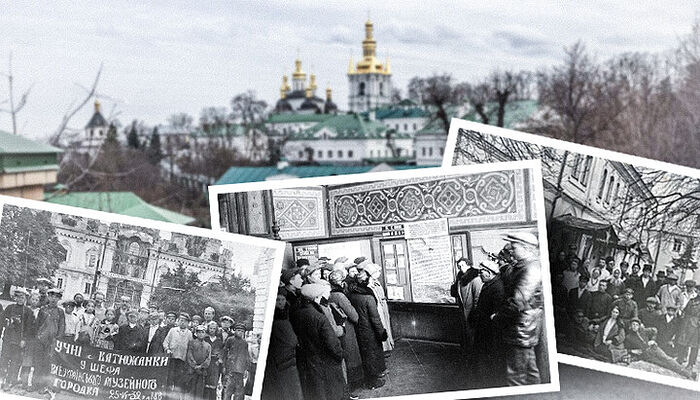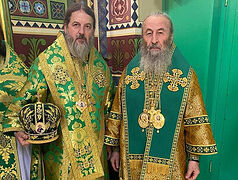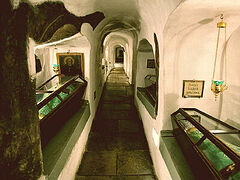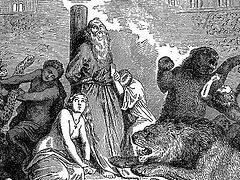As our readers already know, the Kiev government is trying to evict the Orthodox monks from the Kiev Caves Lavra—the cradle of Russian monasticism and one of the most sacred places in all Rus’, where rest the relics of hundreds of monastic saints. Just recently, the Ukrainian minister of culture announced that once all the monks are evicted, the Kiev Caves Lavra would be used as a rehabilitation center for soldiers. Probably that could sound noble if the Kiev Caves Lavra were the only building left standing in all of Ukraine remotely suitable for housing invalids, but the banal repetition of communist anti-Church rhetoric is so thinly veiled that one would have to be a mental invalid himself not to see it.
Here is a little history from the website, Union of Orthodox Journalists.
There has already been a military rehabilitation center in the Lavra. The persecution of the Lavra in the twenty-first century mirrors the tragic history taking place in the early twentieth century.
The events that are now unfolding around the Kiev Caves Lavra and the Ukrainian Orthodox Church (UOC ) mirror the tragic pages of the “red terror” conducted against the Church a century ago. The Trotskyites and Kaganovichs of the twenty-first century are cynically continuing the work of their predecessors, who worked to destroy the Orthodox faith in our land at the beginning of the twentieth century.
The little-known testimony of historian and archaeologist Nadezhda Vladimirovna Linka, a contemporary to those events, show through historical documents that the cases of former and current persecutors and expropriators of church property are the same.
N.V. Linka participated in the creation of the All-Ukrainian Museum Town on the territory of the Kiev Caves Lavra, and was later a senior researcher at the Institute of History. Her memoirs show that the repetition of today’s persecutions against the Lavra and the Church as a whole is systematic in nature and matches in detail the scenario of the destruction of faith by the GPU/CHEKA security officers. The headlines in the odious magazine, The Atheist, differ little from the slogans of current activists: “The den of monks’ must be destroyed”; “Monks’ haven in the State Museum”. At the entrance to the Lavra over the Holy Gates hung a huge slogan on a red cloth that read, “Monks are the bloody enemies of the working people.”
The recent proposal of Minister of Culture Tkachenko to create “structures for the rehabilitation of the military” on the territory of the Lavra is as if copied from Bolshevik circulars.
Exactly one hundred years ago, in 1923, the “Comrades Mausers”1 from the local social services department established a “town” on the territory of the monastery for the disabled of the revolution and those injured on the front in the war.
Invalids of the revolution in the Lavra
The legal adviser of the Lavra, Professor Ivan Nikodimov, wrote that the residents of the Invalid Town had peculiar behavior: “At the very entrance to the Lavra, pilgrims were met with shouts, drunken songs, music, swearing, and all kinds of noise.”
In “Essays on the history of the Kiev Caves Lavra and National Reserve” (Kiev, 1992) we read, “Despite the fact that there was a Museum of Cults and everyday life on the territory of the Lavra, as well as a number of other scientific and cultural and educational institutions, from 1923–1926 the actual owner here was the Center for the Disabled (there was also a prosthetics factory, a production gang, and polytechnic courses for the disabled).
“These very peculiar residents, as well as their frequent guests—'parishioners’ living in the ‘town’ on the territory of that sacred place—drunk on denatured alcohol or some other cheap liquor, would defecate by the altar walls of churches, desecrate the Nativity Necropolis at the Far Caves, where, while spitting on the graves as the passed by them, destroyed the tombstones of their distinguished compatriots, staged drunken orgies and scenes of outright debauchery, and sang obscene songs.
“The police did not interfere much until it came to a stabbing or some other violence… Evicting ‘comrades who were disabled on the fronts of the revolution’ was a virtually hopeless proposition.
“Archival documents show that ‘the invalids wounded on the Kolchak fronts’ plundered and destroyed church property, burned antique furniture in furnaces, smashed two-hundred-year-old porcelain dishes—having seen, for example, a portrait of the tsar or a coat of arms with a double-headed eagle on it. The center’s administration illegally sold church valuables. The director of the museum, Kurinny, informed the state security agencies that the disabled people were attempting to seize the museum premises. For example, shortly before the reorganization of the Lavra into a Historical Reserve, the invalids tried to occupy the Economics Building and the Church of All Saints.”
“Inventory” of relics
Historian Nadezhda Linka described in detail the closure of the churches of the Lavra and the “inventory of museum exhibits”—the relics of revered Orthodox saints, the venerable fathers of the Kiev Caves. According to her, in 1922, all the relics in the Near and Far Caves were uncovered, and the commission’s inventory lists called them “more or less mummified corpses and human bones.” Subsequently, blasphemy was committed many times in the “relics laboratory”: there was a microbiological analysis of “mummified corpses” conducted.
“Since 1926, museums have been housed and arranged in the museum town, carrying out their activities in the extremely complex and peculiar environment on the territory of the famous and ancient monastery... Here, under the shadow of the age-old glory of the Lavra, by the twentieth century there was a whole army of idlers, malingerers and hangers-on who would sit down to the monastery table. Until 1926, the monastery buildings were at the disposal of the district department, which settled its own tenants there.
“In the Far Caves, several houses were provided to invalids of the First World War, who had completely lost their sight from the effects of poisonous gases. These poor blind people often consoled themselves with a drink in rather violent and obscene company. The monastery hotel with many separate rooms and apartments was densely populated by families of workers and employees of neighboring factories and institutions. There were also the monastery cellars, which were now leased to the wine agency, who kept large stocks of wine in them. Employees of this institution often took samples of these goods, freely treated their neighbors there, and sold alcoholic beverages.
“Many higher-level institutions believed that the museum was a kind of almshouse, where any person who was unable to perform basic functions, but still required some attention and help, could be sent to work and receive living quarters. These people, mostly [Communist] Party members, the sick, the disabled, and often just alcoholics, were to be moved into vacant apartments. Some had to be enrolled in the staff of one of the museums, although they had nothing to do with museum work and often behaved very irreverently. All this very motley, heterogeneous population of the museum town was in a state of constant mutual hostility, disputes, and discord over every square meter of living space.”
How the Ministry of Culture Bolsheviks took property away from the Church
The Bolsheviks began to register all the property of the Lavra. Here is how N. Linka describes it:
“A government commission was appointed to conduct inventory and transfer all the property; there were representatives from the city committee and the district executive committee. Again, all the museum bigwigs refused to participate in this unpleasant, but entirely unique, extraordinary procedure. And again, I was included in this commission from the museum, as a “caveman” who was accustomed to monastic mores. They began taking property from the main Dormition Cathedral in the Upper Lavra, and mainly from the central altar. On the holy altar table was a huge silver tabernacle (424 kg) in the shape of a church, made in the twentieth century, a gift from the manufacturer Kuzmichev. Magnificent were the Gospels in silver frames, enameled crosses, chalices, and diskoses—all the precious utensils gifted to the Lavra by many generations of believers.
“But it was terrible and disgusting to see near these sacred treasures all the filth and blasphemous mockery of the holy places so highly revered in the eyes of believers.
“In the walls of the altar, more than a meter thick, zinc boxes were mounted in certain places, where water flowed down that had collected on the cold walls from people’s breath, the flames of candles, lamps, and censers. These water collection boxes were now filled with stinking urine. Dirty rags, scraps of brocade, and women’s stockings were lying in a heap.
The members of the commission were dumbfounded and uncomfortable, and I was not at all at ease. Only Fr. Mikhail (Chaliy, a renovationist), the last abbot of the monastery and the community’s representative, was not at all embarrassed and merely shrugged his shoulders at the commission’s protests, saying, ‘We are all human, all human.’ He understood, of course, that his career was over, that there was nothing good in store for him, and he did not hide his cynicism. Perhaps he imagined that such ‘anti-religious’ behavior would sway the members of the commission in his favor.
“A few days later, having finished inventory of the property in the Cathedral, the commission went to the Near Caves. We started with the Church of the Exaltation, built at the beginning of the eighteenth century over the entrance to the underground cemetery. There were few silver utensils in the altar of this church, but there was even more dirt, disorder and irreverence than in the Cathedral. I went off to record the icons, and gave the men space to do their work. They were laughing, and Fr. Mikhail was all excited and showing off his eloquence. One could, of course, guess the topic of such a lively conversation. The next day we went to the Near Caves. In the caves Fr. Mikhail completely let himself go and loudly spat on his seal before pressing it to the sealing wax. The lively male conversation resumed, punctuated again and again by outbursts of laughter. Thus did the final hours of the ancient, once great monastery become a farce…
“The situation with the tour guides was moving slowly. There was a suspicious-looking priest who had renounced his priesthood and now offered his candidacy. He was trying to make a career in anti-religious work. Then an old man came who assured us that he had graduated from the Historical Physiology department; and then there was an illiterate but bold young man from the ‘Union of Atheists’, along with other such examples. When we checked them out, the work of some of these guides was simply scandalous. The brave atheist especially distinguished himself. In the Dormition Cathedral he pointed to the steam heating grate and announced that there ‘the unfortunate victims of the monastic executioners languished in gloomy dungeons.’ The further he went, the worse it got. In the church above the Near Caves he orated: ‘Here, in the middle of the church gushed a fountain of eau de cologne, naked women walked around, and the monks took them off to secluded caves.’”
The terrible fate of the blasphemers
Terrible was the fate of a number of members of the Museum of Cults and Customs, who had been installed in the portion of the Most Holy Theotokos. N.V. Linka reports that one of the pioneers of this business, D. Shcherbakovsky, committed suicide by drowning himself in the Dnieper River. The People’s Commissar of “cultural construction” in Ukraine, Skrypnyk, one of those who determined the Party’s policy towards the Church, shot himself in 1933. The compiler of the inventory of the seized Lavra icons, Chernogubov [“Black lips”], whose personality corresponded to his surname, “was a complete cynic to the core; his words would have astounded even Mephistopheles”, was shot by the German soldier who guarded the territory in late 1941. Others informed on and slandered their colleagues, and then they themselves were tried and repressed.
“The deputy scientific director, Lobkov, consigned himself to a shameful death. “An illiterate and impudent man, a former foreman, an alcoholic with a pockmarked face and small suspicious eyes, whose appointment was only owing fact that he had called someone from the heads of departments and growled, ‘Hey, you, see (obscene expression) that everything is fine, that there ain’t no counter-revolution!’ He often stupefied visitors with his strong expressions and pungent aroma—because during periods of particularly abundant alcohol consumption, he would not manage to get to the WC in time. In the late ‘30s, when he was returning home after a night of heavy drinking, he lay down to rest on a trunk in the Jewish Bazaar (now called Victory Square). It was a severe frost, and the next morning he was found frozen to death.”
A person’s or society’s war against God and His Church inevitably leads to a war against Life. This is because the one whose ally a person becomes in this war, even if unknowingly, is darkness, lies and death. And no matter how outwardly patriotic his words are, there is only death behind them. This is being confirmed by the “red terror” deployed against the Church of Christ today.
During the seizure of a church in the Kiev region, a man who snatched a cross with a Crucifix from a priest and threw it to the ground instantly died in convulsions in front of everyone. The Lord allowed millions to see the video of this terrible death to enlighten those who, having succumbed to the rabid propaganda spread by false believers, fell for the temptation and supported the theomachists of the twenty-first century.





